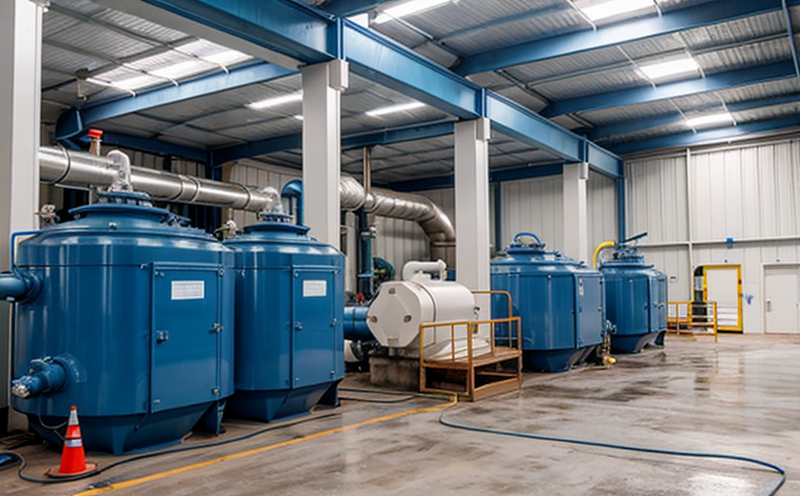IMO D-2 Ballast Water Performance Standard Testing
The International Maritime Organization's (IMO) Ballast Water Management Convention sets stringent guidelines aimed at reducing the spread of harmful aquatic organisms and pathogens through ballast water. The convention mandates that all ships must comply with a performance standard known as the IMO D-2 discharge criteria, which limits the amount of viable pathogens and other harmful substances in ballast water.
Our laboratory provides comprehensive testing services to ensure compliance with these stringent regulations. Our team specializes in assessing the effectiveness of ballast water treatment systems against the D-2 standard. The testing process involves simulating real-world conditions in a controlled environment, ensuring accurate results that reflect actual maritime operations.
The IMO D-2 discharge criteria require that ballast water be treated to such an extent that it can contain no more than 10 viable organisms per milliliter of water (10 cells/ml). This stringent standard necessitates sophisticated and precise testing methodologies. Our laboratory employs advanced analytical techniques, including microbial culturing, DNA-based methods, and other cutting-edge technologies to verify compliance.
Our testing services are designed to meet the needs of quality managers, compliance officers, R&D engineers, and procurement professionals involved in the development and certification of ballast water treatment systems. Our laboratory ensures that clients receive accurate, reliable data that can be used to demonstrate compliance with international regulations.
The importance of IMO D-2 compliance cannot be overstated. Non-compliance can result in significant financial penalties, operational disruptions, and reputational damage. By partnering with our laboratory for testing services, organizations can ensure they are meeting all regulatory requirements and maintaining a competitive edge in the global shipping industry.
To achieve successful outcomes, it is essential to understand the complexities involved in ballast water treatment system performance testing. This includes comprehending the specific challenges faced by different types of vessels operating under varying environmental conditions. Our laboratory has extensive experience in this area, providing clients with tailored solutions that address their unique needs and operational contexts.
Our services extend beyond mere compliance verification; we also offer valuable insights into improving system performance through detailed analysis of test results. This proactive approach allows our clients to optimize their treatment processes and enhance overall vessel efficiency.
Applied Standards
| Standard | Description |
|---|---|
| IMO D-2 | The discharge criteria that limits the amount of viable organisms in ballast water. |
| ISO 16540-3 | Microbiological quality of water intended for human consumption - Determination of total viable count and classification of microbial quality. |
| ASTM D7829 | Determination of the number of microorganisms in ballast water by flow cytometry. |
Scope and Methodology
| Scope | Description |
|---|---|
| Treatment Effectiveness | Evaluation of the ballast water treatment system's ability to reduce viable organisms below the D-2 limit. |
| System Suitability | Determination that the treatment system is suitable for use on board ships under various operational conditions. |
| Environmental Impact Assessment | Evaluation of any potential environmental impact associated with the treatment process. |
The methodology we employ involves a series of rigorous tests designed to assess the performance of ballast water treatment systems against the IMO D-2 discharge criteria. These tests include:
- Sampling: Collecting representative samples from treated and untreated ballast water.
- Culturing: Cultivating microorganisms from the samples for quantification using standard microbiological techniques.
- DNA-Based Methods: Utilizing PCR-based methods to identify specific pathogens present in the samples.
- Flow Cytometry: Employing flow cytometers to count viable cells and differentiate between living and dead organisms.
The results of these tests are then analyzed using statistical tools to ensure that they meet or exceed the D-2 criteria. Our laboratory ensures that all testing is conducted in accordance with internationally recognized standards, providing clients with confidence in the accuracy and reliability of our findings.
Customer Impact and Satisfaction
Our commitment to excellence has earned us a reputation for providing high-quality services that meet or exceed customer expectations. We consistently receive positive feedback from quality managers, compliance officers, R&D engineers, and procurement professionals who rely on our expertise.
By partnering with our laboratory, clients can ensure they are meeting all regulatory requirements while also benefiting from expert guidance in optimizing their treatment processes. This proactive approach helps organizations maintain a competitive edge in the global shipping industry.
We pride ourselves on delivering accurate, reliable data that can be used to demonstrate compliance with international regulations. Our services not only help clients meet legal obligations but also contribute to environmental sustainability by reducing the spread of invasive species and pathogens.
Our team is dedicated to providing comprehensive support throughout the testing process, from initial consultation through final report delivery. We understand the importance of timely results and strive to deliver them in a manner that meets your specific needs and timelines.





